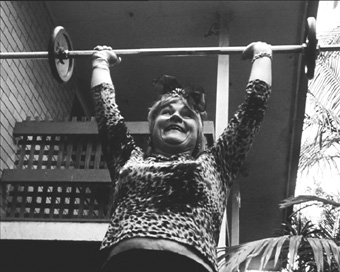The high art of limited means
Danni Zuvela

Let
The opening sequence of Let establishes the film’s theme. A north American male voice introduces us to the characters: “There’s John from China; Tegus from Dover, England; the lovely Annabelise from Argentina; and me, your humble narrator, from Paris….Texas.” A deliberately international flavour permeates both the story and form of the film, winner of the Most Original Script and Best Tertiary Drama categories at the recent Queensland New Filmmakers Awards.
Let concerns a group of young international students who devise a cunning way of manipulating their landlady. It’s also about co-existence and its impact on moods and feelings with a New Wave look. Black and white, grainy and handheld, the film moves through its 7.5 minutes with cool music and an ironic, self-reflexive voiceover that situates it squarely in the international artfilm tradition.
Filmmakers Joel Higham, Ching-Cheng Peng and Ricardo Diaz say the look and feel of the film was largely necessitated by their production situation. The film was a Masters project—the introduction of a 16mm course at Griffith University. Using the stock supplied by the university—14 minutes of black and white reversal—they had to script, shoot and edit the film in a matter of days. Deadline-induced pragmatism meant that roles were conflated, with all 3 acting as directors, producers, gaffers and cinematographers to bring the project off in time. As Diaz says, “It’s impossible to disentangle what each person did.”
The idea for the story emerged when Ching suggested focusing on their lives as international students living in Australia and Ricardo told them about the energetic woman who ran the student complex where he lived. Let was born as a ‘Spanish Apartment-style’ story about the joys and difficulties of multicultural and multigenerational co-existence. It’s also quite a risque story with drug abuse at its centre. The filmmakers were keen to produce something with an edge, and thought, says Ricardo, “it was time to play with being a bit twisted in a politically incorrect way”
As visitors to Australia, they’ve had time to digest some of the local politics around race, migration and refugees, and the film is a cheeky response to both right wing “paranoia about migration” and earnest, but safe social justice orientations in filmmaking. The play with stereotypes of “a bunch of students from different backgrounds” was a deliberate choice, with characters like “the Asian tech freak and the sexy Latin girl.” The filmmakers, Ricardo says, strove for “a ‘ridiculisation’ of Hollywood clichés.”
“Being a Mexican,” says Ricardo, “I really wanted to do this for the notoriously gross portrait of my fellow countrymen by the American industry and its ingestion by…well, everybody.” Ching’s first AD work in Taiwan provided technical expertise and another perspective: “Western and Eastern, they’re 2 very different ways of thinking. The others looked at a scene in very different ways to me, and I appreciated that—I want to know their way of thinking, their ideas, so I can grow, and be a better filmmaker… we worked together very well, with our very different talents.”
Joel, originally from Canada (it’s his laconic drawl we hear on the voiceover), spent a year studying in France and got “hooked on Godard.” All are fans of arthouse cinema and the New Wave in particular, but as Ricardo explains, “Aesthetically, we were framed by our materials and circumstances, so to do it New Wave was the perfect solution.” The lack of audio equipment dictated the voiceover and the “slightly voyeuristic shots and the use of handheld camera” was further enhanced “by the slightly satiric undertone of the whole piece”, says Ricardo. For Joel, “part of the beauty of that kind of style is that it’s not perfect.”
Production, Joel recalls, “really ended up being guerilla film fare. There wasn’t enough pre-production, there wasn’t enough crew. We had to work fast and cut shots on the fly. We were working with 15 minutes of film stock on a 7 minute script, which meant no room for error, and we had about a day and a half to shoot it. But I guess you get to a point where you have to go for broke and see what happens.”
Actors were recruited from the cinematography course and when it came to finding a location, they realised “we did know a big trashed house full of students who were happy to let us film there as long as we bought pizza. That means the whole film cost about $27—the cost of 3 pizzas.” An exaggeration, Ricardo points out, as they still had to purchase mini DV tapes, but with the course covering the film and equipment hire, and music supplied by acquaintances, the whole production cost less than $100: a triumph of turning limitations into attributes.
Let’s mature accomplishment proves what other Queensland filmmakers such as the Spierigs have been saying for years now: if you have a willing and creative crew, miniscule budgets need not prevent imaginative genre filmmaking.
Let, written, directed and produced by Joel Higham, Ching-Cheng Peng and Ricardo Diaz; Queensland New Filmmakers Awards, Queensland Conservatorium, Griffith University Theatre, April 22
RealTime issue #61 June-July 2004 pg. 18






